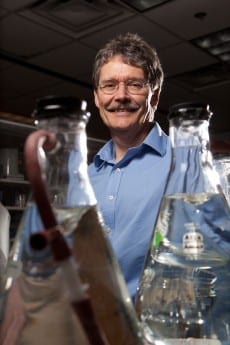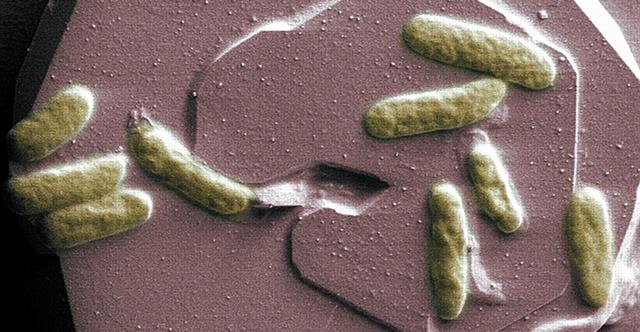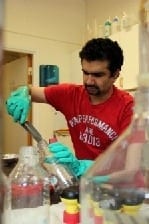
A future aim is to try to convert the greenhouse gas, carbon dioxide, into the renewable fuel, methanol, much more efficiently.
Taking their inspiration from Nature, scientists at the University of New South Wales have developed a new method for carrying out chemical reduction – an industrial process used to produce fuels and chemicals that are vital for modern society.
Their catalyst-based approach has the big advantages that it uses cheap, replenishable reagents and it works well at room temperature and in air – so much so, it can even be carried out safely in a teacup.
The research, by a team led by Associate Professor Stephen Colbran, of the UNSW School of Chemistry, has been published as the cover of the prestigious journal, Angewandte Chemie.
The catalyst they designed mimics the activity of naturally occurring enzymes that catalyse reduction, such as alcohol dehydrogenase in yeast, that helps produce alcohol from sugar.
“Industrial chemical reduction processes underpin human existence, but are unsustainable because they irreversibly consume reagents that are made at prohibitively high energy cost,” Dr Colbran says.
“We believe our new biomimetic design may have wide applications in chemical reduction.”
Chemical reduction involves the addition of electrons to a substance, and is the basis of making many fuels, including the sugars that plants produce during photosynthesis.
In industry, molecular hydrogen and reactive reagents such as sodium borohydride are used as reducing agents during the production of pharmaceuticals, agrichemicals and ammonia for fertiliser.
“Manufacture of these substances is energy costly, leads to the release of carbon dioxide and they are difficult to handle and store,” Dr Colbran says. “So we decided to look at nature to see how nature does it.”
The team combined a transition metal complex containing rhodium with a Hantzsch dihydropyridine – an organic donor of a hydride ion similar to biological nicotinamides – to produce the new bio-inspired catalyst. They tested it on a common process – reduction of imines – and were surprised to find it worked in ambient conditions with more than 90 per cent efficiency in most cases.
Dr Colbran even tested it out in a teacup. “I thought it would be a bit of fun. And it makes a serious point – our catalyst system is very easy to use.”
The Latest Bing News on:
Carbon dioxide to fuel
- Xeneta Finds Supply Chain Diversions Fuel Spike in Carbon Emissionson April 26, 2024 at 1:32 pm
New data from Xeneta reveals an eye-popping increase in emissions as a result of the Red Sea diversion. The Xeneta and Marine Benchmark Carbon Emissions Index (CEI) shows carbon emissions increased ...
- As Illinois weighs carbon dioxide pipeline moratorium, feds recommend technologyon April 23, 2024 at 2:10 am
As state lawmakers weigh carbon capture and sequestration regulations, federal officials are trying to woo support in Illinois.
- General Galactic emerges from stealth to make methane from carbon dioxideon April 22, 2024 at 9:00 am
The stealthy new startup hopes a fully integrated approach, from direct air capture to electrolysis and methane generation, will let it drive prices down for so-called e-fuels.
- Carbon Dioxide Levels Have Passed a New Milestoneon April 20, 2024 at 2:01 am
Evacuating Pets: When disaster strikes, household pets’ lives are among the most vulnerable. You can avoid the worst by planning ahead.
- Offshore wind turbines won't reduce carbon dioxide emissions. This is whyon April 20, 2024 at 1:15 am
Our elected leaders consider the complete environmental impact of wind farms, least they impose a solution that makes the problem worse.
- Summit to make its carbon pipeline permit case again in NDon April 19, 2024 at 4:19 am
Tharaldson Ethanol remains the only North Dakota plant in the project. The project has grown from 31 plants to 57 plants after another carbon pipeline project, Navigator CO2 Ventures, abandoned its ...
- Report explores possibilities of capturing and using carbon dioxide for sustainable production routeson April 15, 2024 at 11:45 am
Suitable CO2 sources and integration in PtX value chains" deals with possibilities of capturing and utilizing carbon dioxide for sustainable production routes. Carbon dioxide can serve as a carbon ...
- A Gates-backed startup is making fuel from water and carbon dioxideon April 9, 2024 at 5:52 pm
A slogan on the company’s trucks reads: “Clean fuels made from renewable energy and carbon dioxide.” Hydrocarbons — compounds of hydrogen and carbon atoms — are the basis of crude oil ...
- Heat-trapping carbon dioxide and methane levels in the air last year spiked to record highs againon April 7, 2024 at 5:00 pm
Carbon dioxide emissions going into the air from burning fossil fuels and making cement hit an all time high last year of 36.8 billion metric tons, twice the amount spewed into the air 40 years ...
The Latest Google Headlines on:
Carbon dioxide to fuel
[google_news title=”” keyword=”carbon dioxide to fuel” num_posts=”10″ blurb_length=”0″ show_thumb=”left”] [/vc_column_text]The Latest Bing News on:
CO2 to fuel
- Taking Personal Responsibility: 10 Practical Tips to Combat Climate Changeon April 30, 2024 at 1:02 am
Transportation is a major source of carbon emissions. To reduce your carbon footprint, consider walking, biking, or using public transportation. If you drive, ensure your vehicle is well-maintained ...
- How one methanol ship can make up to 75 fuel oil vessels compliant with FuelEUon April 29, 2024 at 11:23 pm
Finnish pool start-up Ahti Maritime has revealed how 70 vessels burning heavy fuel oil (HFO) can be made compliant with FuelEU regulations by just a single e-methanol ship. The European Union scheme ...
- Say no to CO2 pipeline projects in Illinois until safety is assuredon April 29, 2024 at 4:00 am
We need legislative guardrails to ensure that projects involving carbon capture and sequestration legitimately serve the economic and environmental interests of all Illinois citizens.
- Crickets for protein and CO2 for jet fuel: How these innovators are tapping unlikely sources for sustainable solutionson April 28, 2024 at 1:00 pm
Using innovations to address climate change and food resilience, The Liveability Challenge winners pave the way for a greener future. Read more at straitstimes.com.
- Hennen: Opposition to CO2 pipeline fadingon April 27, 2024 at 6:37 am
Columnist Scott Hennen writes about North Dakota Public Service Commission meetings about a CO2 pipeline permit request from Summit Carbon Solutions.
- Renewable diesel a more effective tool to decarbonize trucking than BEV, report sayson April 24, 2024 at 1:16 pm
ATRI finds that renewable diesel produces less lifecycle CO2 than a battery electric conversion and comes with far lower costs.
- Latest round of seed grant winners announcedon April 22, 2024 at 12:00 pm
Our proposal aims to investigate the feasibility of this solar-powered, ocean-based CO2-to-fuel conversion technology.” Another SI-GECS grant was awarded to Connell School of Nursing Associate Dean ...
- General Galactic emerges from stealth to make methane from carbon dioxideon April 22, 2024 at 9:00 am
The stealthy new startup hopes a fully integrated approach, from direct air capture to electrolysis and methane generation, will let it drive prices down for so-called e-fuels.
- Can this ocean-based carbon plant help save the world? Some scientists are raising red flagson April 20, 2024 at 5:00 pm
Equatic has already signed a deal with Boeing to sell it 2,100 metric tons of hydrogen, which it plans to use to create green fuel, and to fund the removal of 62,000 metric tons of CO2.
- Carbon Dioxide Levels Have Passed a New Milestoneon April 19, 2024 at 4:59 pm
As carbon dioxide builds up in the atmosphere ... This is why global fossil fuel emissions are still at record-high values (with a brief dip during the pandemic). And they stayed high in 2023 ...
The Latest Google Headlines on:
CO2 to fuel
[google_news title=”” keyword=”CO2 to fuel” num_posts=”10″ blurb_length=”0″ show_thumb=”left”]










